Can I run for president?
Well, no, you can’t. Not if you’re Canadian (unless you’re the
Ted Cruz kind of Canadian,
then you’re fine). Here in Canada, potential prime ministers aren’t
technically subject to a set of qualifications—there are no official age
restrictions and no citizenship requirements, for example. In practice, prime
ministers are members of Parliament, which means they’re Canadian citizens who
are at least 18 years old. South of the border, however, Americans apply three
stringent criteria to their presidents: be a natural-born citizen; be 35 years
of age or older; and have been a resident of the U.S. for 14 years. That’s
just what’s in the legal books. In reality, you’re unlikely to become
president unless you’re also male, white (present White House occupant
notwithstanding), Christian, over 50 years old, have earned a
post-secondary degree, and either served in the military or practiced
law. With the exception of military service, that pretty much describes most
Canadian prime ministers, too.
American presidents: common characteristics

And then there’s the prohibitive cost. Once the Canadian campaign period
begins, candidates must adhere to spending limits. But in the U.S. there is no
such legislation. By the end of the (very, very, very long) campaign,
presidential candidates can spend up to
near $1 billion (all amounts in US$).
To get near the office, you’ll need friends in high places, a lot of money,
and superior fundraising skills.
Presidential election spending, 2012
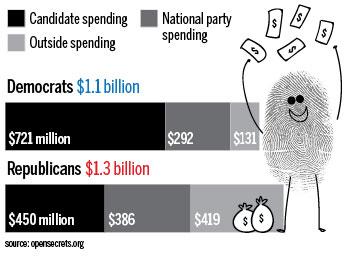
The candidates
Once you decide to run, you join a pool of other interested contenders. At the
beginning of the current primary period, for instance,
23 Republican and Democratic party candidates
had declared themselves. By July, each party will have chosen just a single
nominee. These candidates will almost always fall into one of two parties —
Republican (red) or Democratic (blue). American political ideology tends to
trend to the right of Canadian politics. This electoral season, the
front-runner Republicans (Trump and Cruz) don’t differ much from one another
and are ideologically far to the right. On the other hand the “left-ish” party
players (Clinton and Sanders) differ significantly — with one presenting as
even more left-leaning than current Canadian politicians.
American and Canadian political ideologies
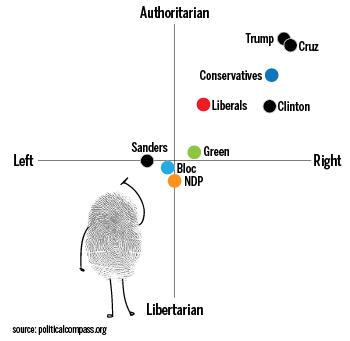
The long road begins
If there’s one good thing about the excessive length of the American campaign
period, it’s that it makes Canadians feel better about the
relative brevity
of ours. Campaigning usually starts almost two years before Election Day, when
the first candidates declare their intentions to run.
National election campaign length
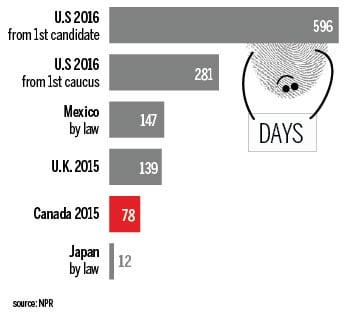
Jammed into the middle of this drawn-out process is the ever-confusing season
of state primaries and caucuses. This is how 23 candidates dwindle down to
just two.
American election timeline
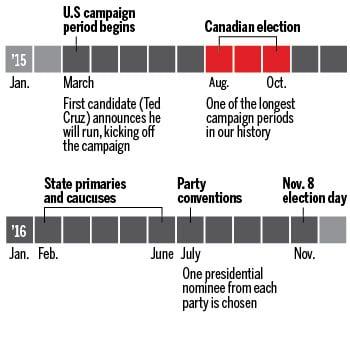
Primaries and caucuses
Beginning in February, a series of elections are held in every state and
overseas territory. In some states these are called primaries, in others they
are caucuses. The point of both practices is to apportion pledged delegates
among candidates in each party. Pledged delegates are party members who have
the power to vote for that candidate at their respective national party
convention, typically held in July. Basically, a primary is an election open
to registered voters in the state (sometimes all, sometimes just party
members), and a caucus is a series of small gatherings of party members who
often raise their hands or gather in groups to show their support. In order to
secure the party nomination for president, candidates need to have a majority
of delegates. This number is different for both the Democratic and Republican
parties.
Delegates needed for party nomination

The mechanisms for both primaries and caucuses differ widely by state, and
even by party. Suffice to say that almost no two contests are alike. One major
difference separates Democrats from Republicans: superdelegates. Only the
Democrats select super delegates. That group comprises 719 delegates who don’t
pledge their candidate allegiance in advance of the convention. They include
former presidents, current legislators, and elected party officials.

At the end of this five-month-long process are the party conventions. This is
where each party’s presidential nominee—typically, the one with the most
delegates—is formally nominated. Barring extraordinary circumstances, nominees
are known in advance and conventions are foregone conclusions. Keep an eye on
the Republican convention in July, which may not be so ordinary.
Campaigning and swing states
You’ll notice that once the party nominees hit the campaign trail in autumn
just before the general election, a handful of states receive a lot of
attention. These are swing states, where razor-thin polling margins mean
anyone could win. Most states are “safe,” in that voters’ preferences are
generally predictable. Candidates don’t waste resources on states where the
outcome is certain, win or lose. Strategically, it makes sense to focus
campaigns on trying to swing the undecided states.
2016 most-likely swing states
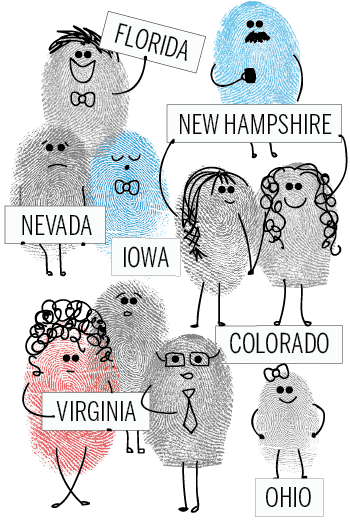
Election Day and the Electoral College
Only 538 people vote directly for the president. Wait. What? We’ll try to
explain. But trust us, it doesn’t make a whole lot of sense for a modern
democracy. These 538 people form the body of electors, known as
the Electoral College,
that ultimately vote on behalf of millions of Americans who cast ballots. On
Nov. 8, when Americans head to the polls, their choices don’t directly pick
the president, but instead they determine which candidate each state’s
electors will support. Each state is allotted a certain number of electors who
are nominated in advance. On Election Day, a vote for a presidential candidate
is actually a vote for a slate of electors who’ve pledged to vote for that
party. In many states, ballots only list the names of presidential nominees,
so it’s not surprising that so many people think they’re voting directly for
the president. Each state gets the same number of electors as it has
congressmen and senators. Each state has two senators and the number of their
congressmen is based on population. So, the more populous a state, the more
electors it gets. No state has fewer than three.
States with the most Electoral College votes
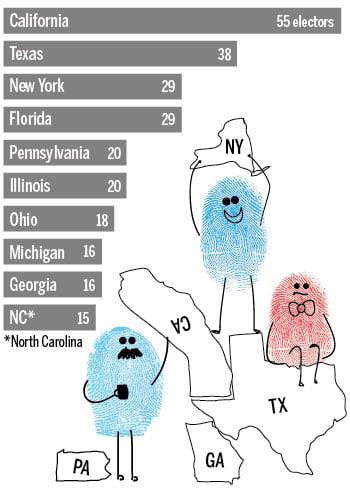
How are the electors in a state distributed between candidates? They’re not.
It’s winner-take-all (in every state but Maine and Nebraska), and the
candidate who wins the most votes gets all the electors—also known as
electoral votes. This is how entire states go blue or red. A candidate must
win at least 270 of the 538 electoral votes across the U.S. in order to
declare victory. It isn’t until December, however, that the electors head to
their state capital to cast their pre-determined votes.
Uh, could you repeat that please?

Who’s running this ship?
You know Elections Canada? Its
sole responsibility is administering Canadian federal elections—enforcing
legislation, monitoring spending, producing maps of electoral districts,
training election officers, and much more. They make sure elections run
smoothly across the country. The United States, however, has no such governing
body. In fact, there are thousands of independent local entities that manage
elections without uniform procedures. Every single state does things slightly
differently. Decisions made state-by-state (by government, local entities, or
state political parties) include whether to hold a primary or caucus, how to
select delegates, how to select electors, whether ID is required to vote, or
if you need to register in advance, what the ballots say and look like, how
votes are counted, and on and on. No wonder it’s so confusing.
Now what?
Congratulations! Now you understand American politics! … right? That’s okay,
millions of Americans struggle through this process every four years. Luckily
for the rest of us, it’s just an interesting read.



Correction: This story originally stated that the Prime Minister of Canada
is not subject to any test of qualification. Of course, constitutional
convention dictates that, in practice, prime ministers are members of
Parliament—and therefore subject to the same qualifications as every MP.
Maclean’s regrets the error.
By Amanda Shendruk, with
research assistance from
Nick Taylor-Vaisey Do you see
something that needs a fix? Email [email protected]
